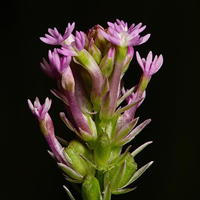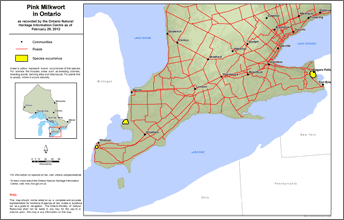Pink milkwort
Scientific name: Polygala incarnata

Cover photo credit: Allen Woodliffe
Status
Endangered
“Endangered” means the species lives in the wild in Ontario but is facing imminent extinction or extirpation.
Date added to the Species at Risk in Ontario List
The Pink milkwort was already assessed as endangered when the Endangered Species Act took effect in 2008.
Read the Assessment Report
What it looks like
The Pink milkwort is a very slender annual plant with a single, unbranched or sparingly branched stem that reaches up to 40 centimetres tall.
It has only a few small, narrow alternately arranged leaves. Pink or rose-coloured flowers grow in dense clusters in the summer.
Where it lives
Pink milkwort grows in moderately moist to dry, sandy, prairie habitats, where it is often found growing with Little Bluestem grass (Schizachyrium scoparium). Periodic fire is important to maintain open prairie conditions.
Where it’s been found in Ontario
This plant’s North American range extends from Long Island, New York, west to Iowa and south to Florida and Texas. It is most abundant in the Carolinas, Oklahoma and Nebraska.
In Canada, Pink milkwort is found only in southwestern Ontario on Walpole Island First Nation and around Windsor.
View a Larger version of this map (PDF)
What threatens it
The main threats to Pink milkwort are habitat destruction (from urbanization and agriculture) and natural succession, where trees and shrubs grow in previously open areas and outcompete prairie plants. An additional threat is invasive plants such as Black locust, White sweet clover and European common reed.
Action we are taking
Endangered Species and their general habitat are automatically protected.
Recovery strategy
A recovery strategy advises the ministry on ways to ensure healthy numbers of the species return to Ontario.
Read the Executive Summary and Full Document (January 28, 2016)
Government response statement
A government response statement outlines the actions the government intends to take or support to help recover the species.
Read the government response statement (October 28, 2016)
Review of progress
A review of progress made toward protecting and recovering a species is required no later than the time specified in the species’ government response statement, or not later than five years after the government response statement is published if no time is specified.
Read the report on progress towards the protection and recovery of 18 species at risk, including Pink Milkwort (2021).
Habitat protection
General Habitat Protection - June 30, 2008
What you can do
Report a sighting
The Ministry of Natural Resources and Forestry tracks species at risk such as the Pink milkwort. Report a sighting of an endangered animal or plant to the Natural Heritage Information Centre. Photographs with specific locations or mapping coordinates are always helpful.
Volunteer
Volunteer with your local nature club or provincial park to participate in surveys or stewardship work focused on species at risk.
Be a good steward
- private land owners have a very important role to play in species recovery; if you find Pink milkwort on your land, you may be eligible for stewardship programs that support the protection and recovery of species at risk and their habitats
- invasive species seriously threaten many of Ontario’s species at risk; to learn what you can do to help reduce the threat of invasive species, visit:
www.ontario.ca/invasivespecies
www.invadingspecies.com
www.ontarioinvasiveplants.ca - the Canada-Ontario Farm Stewardship Program is available to farmers registered under the Canada-Ontario Environmental Farm Plan to encourage greater protection and conservation of habitat for species at risk
- Pink milkwort and many other species at risk depend on healthy grassland prairies, a very rare habitat in Ontario; learn more about these habitats, the species that depend on them, and what you can do to help at:
www.tallgrassontario.org. - Pollinators, such as bees, are in steep decline across the globe and they play a key role in the survival of many of Ontario’s rare plants; for information on how you can help scientists monitor pollinator populations in Ontario visit:
www.seeds.ca/proj/poll.
Report illegal activity
Report any illegal activity related to plants and wildlife to
Quick facts
- plants in the milkwort family were once thought to increase milk production in cows and nursing mothers
- fire plays an important role in maintaining open prairie habitat where Pink milkwort lives; fire actually stimulates the growth of these hardy flowers and naturally removes trees and shrubs that would otherwise overtake its habitat
- Pink milkwort flowers are pollinated primarily by bumblebees, which have been in steep decline around the world
- the tiny, hairy seeds of the Pink milkwort are possibly dispersed by ants
